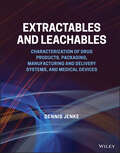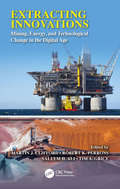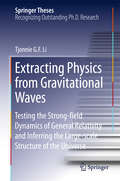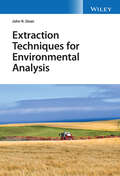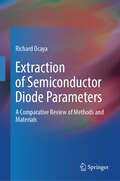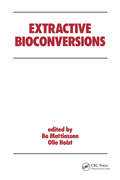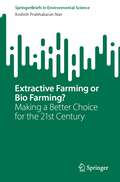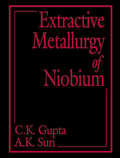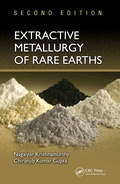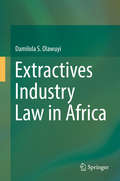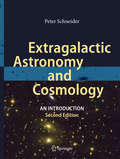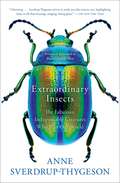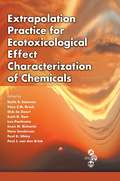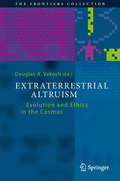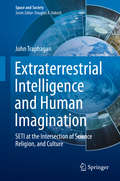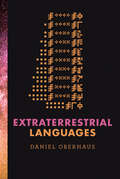- Table View
- List View
Extractables and Leachables: Characterization of Drug Products, Packaging, Manufacturing and Delivery Systems, and Medical Devices
by Dennis JenkeEXTRACTABLES AND LEACHABLES Learn to address the safety aspects of packaged drug products and medical devices Pharmaceutical drug products and medical devices are expected to be effective and safe to use. This includes minimizing patient, user or product exposure to impurities leached from these items when the drug product is administered or when the medical device is used. Clearly, patient or user exposure to leachables must not adversely impact their health and safety. Furthermore, these impurities must not adversely affect key quality attributes of the drug product or medical device, including its manufacturability, stability, efficacy, appearance, shelf-life and conformance to standards. Extractables and leachables are derived from the drug product’s packaging, manufacturing systems and/or delivery systems or from the medical device’s materials of construction. It is imperative to understand and quantify the release of extractables from these items, the accumulation of leachables in drug products and the release of leachables from medical devices. Once extractables and leachables have been discovered, identified and quantified, their effect on the key product or device quality attributes, including safety, must be systematically and scientifically established according to recognized, rigorous and relevant regulatory and compendial standards and industry-driven best practices. In Extractables and Leachables, the chemical compatibility (including safe use) of drugs (and their containers, delivery devices and manufacturing systems) and medical devices is examined at length, focusing particularly on how trace-level extractables and leachables affect the quality and safety of a medical product and how to assess the magnitude of the effect. This is accomplished by addressing the two critical activities required to develop, register and commercialize safe, effective and affordable clinical therapies; measuring extractables and leachables (chemical characterization) and assessing their impact (for example, toxicological safety risk assessment). Each of these activities is addressed in-depth, based on the existing and developing international regulations and guidelines, current published literature and the author’s extensive personal experience. Written by a key contributor to standards, guidelines, recommended practices and the scientific literature, the book provides “insider” insights beyond those gained by merely reading the relevant texts. Given that the rapidly evolving extractables and leachables landscape, this book provides the most current and crucial information on new and forthcoming regulations and best practices. Extractables and Leachables readers will also find: A thorough summary of regulatory and compendial guidelines and the steps required to meet them A detailed and in-depth review of essential scientific principles and recommended best practices for the design, implementation, interpretation and reporting of chemical characterization studies A practical resource for optimizing the development, registration, and commercialization of safe and effective medical products A helpful tool to maximize product development and successful regulatory outcomes Extractables and Leachables is the essential reference for pharmaceutical scientists, analytical chemists, regulatory affairs professionals, engineers, and toxicologists in areas such as product research and development, product registration and approval, regulatory affairs, analytical science, quality control, and manufacturing.
Extracting Accountability: Engineers and Corporate Social Responsibility (Engineering Studies)
by Jessica SmithHow engineers in the mining and oil and gas industries attempt to reconcile competing domains of public accountability.The growing movement toward corporate social responsibility (CSR) urges corporations to promote the well-being of people and the planet rather than the sole pursuit of profit. In Extracting Accountability, Jessica Smith investigates how the public accountability of corporations emerges from the everyday practices of the engineers who work for them. Focusing on engineers who view social responsibility as central to their profession, she finds the corporate context of their work prompts them to attempt to reconcile competing domains of accountability—to formal guidelines, standards, and policies; to professional ideals; to the public; and to themselves. Their efforts are complicated by the distributed agency they experience as corporate actors: they are not always authors of their actions and frequently act through others. Drawing on extensive interviews, archival research, and fieldwork, Smith traces the ways that engineers in the mining and oil and gas industries accounted for their actions to multiple publics—from critics of their industry to their own friends and families. She shows how the social license to operate and an underlying pragmatism lead engineers to ask how resource production can be done responsibly rather than whether it should be done at all. She analyzes the liminality of engineering consultants, who experienced greater professional autonomy but often felt hamstrung when positioned as outsiders. Finally, she explores how critical participation in engineering education can nurture new accountabilities and chart more sustainable resource futures.
Extracting Innovations: Mining, Energy, and Technological Change in the Digital Age
by Martin J. Clifford, Robert K. Perrons, Saleem H. Ali and Tim A. GriceThis book considers the most contemporary innovations propelling the extractive industries forward while also creating new environmental and social challenges. The socio-ecological fabric of innovation in the extractive industries is considered through an integrative approach that brings together engineers, natural scientists, and social scientists—academics and practitioners—giving an empirically grounded and realistic evaluation of the innovations in this sector. It synthesizes a series of questions including:
Extracting Knowledge From Time Series: An Introduction to Nonlinear Empirical Modeling
by Boris P. Bezruchko Dmitry A. SmirnovThis book addresses the fundamental question of how to construct mathematical models for the evolution of dynamical systems from experimentally-obtained time series. It places emphasis on chaotic signals and nonlinear modeling and discusses different approaches to the forecast of future system evolution. In particular, it teaches readers how to construct difference and differential model equations depending on the amount of a priori information that is available on the system in addition to the experimental data sets. This book will benefit graduate students and researchers from all natural sciences who seek a self-contained and thorough introduction to this subject.
Extracting Physics from Gravitational Waves
by Tjonnie G. F. LiTjonnie Li's thesis covers two applications of Gravitational Wave astronomy: tests of General Relativity in the strong-field regime and cosmological measurements. The first part of the thesis focuses on the so-called TIGER, i. e. Test Infrastructure for General Relativity, an innovative Bayesian framework for performing hypothesis tests of modified gravity using ground-based GW data. After developing the framework, Li simulates a variety of General Relativity deviations and demonstrates the ability of the aforementioned TIGER to measure them. The advantages of the method are nicely shown and compared to other, less generic methods. Given the extraordinary implications that would result from any measured deviation from General Relativity, it is extremely important that a rigorous statistical approach for supporting these results would be in place before the first Gravitational Wave detections begin. In developing TIGER, Tjonnie Li shows a large amount of creativity and originality, and his contribution is an important step in the direction of a possible discovery of a deviation (if any) from General Relativity. In another section, Li's thesis deals with cosmology, describing an exploratory study where the possibility of cosmological parameters measurement through gravitational wave compact binary coalescence signals associated with electromagnetic counterparts is evaluated. In particular, the study explores the capabilities of the future Einstein Telescope observatory. Although of very long term-only applicability, this is again a thorough investigation, nicely put in the context of the current and the future observational cosmology.
Extraction Techniques for Environmental Analysis
by John R. DeanExtraction Techniques for Environmental Analysis Explore the analytical approach to extraction techniques In Extraction Techniques for Environmental Analysis, accomplished environmental scientist and researcher John R. Dean delivers a comprehensive discussion of the extraction techniques used for organic compounds relevant to environmental analysis. In the book, extraction techniques for aqueous, air, and solid environmental matrices are explored and case studies that highlight those techniques are included. Readers will find in-depth treatments of specific extraction techniques suitable for adoption in their own laboratories, as well as reviews of relevant analytical techniques used for the analysis of organic compound extracts (with a focus on chromatographic separation and detection). Extraction Techniques for Environmental Analysis also includes a chapter that extensively covers the requirements for an analytical laboratory, including health and safety standards, as well as: A thorough introduction to pre-sampling, as well as the extraction of aqueous samples, including the classical approach for aqueous extraction and solid phase extraction Comprehensive explorations of the extraction of gaseous samples, including air sampling Practical discussions of the extraction of solid samples, including pressurized fluid extraction and microwave-assisted extraction In-depth examinations of post-extraction procedures, including pre-concentration using solvent evaporation Extraction Techniques for Environmental Analysis is a must-read resource for undergraduate students of applied chemistry, as well as postgraduates taking analytical chemistry courses or courses in related disciplines, like forensic or environmental science.
Extraction of Nuclear and Non-ferrous Metals
by Sujay Kumar Dutta Dharmesh R. LodhariThis book presents a comprehensive overview of non-ferrous metallurgy, especially its core principles and fundamental aspects, in a concise form. The book covers all basic concepts and definitions related to metal extraction, and provide succinct summaries of relevant metallurgical processes. It also covers the scientific and engineering aspects of nuclear processes and features special chapter on ultra-high-purity metals. The book employs a step-by-step approach, is written in an easy-to-understand style, and discusses significance of core concepts. As such, it not only offers a valuable guide for professionals and researchers working in the areas of metallurgy, mining, and chemical engineering, but can also be used as a core text in both graduate and professional coursework.
Extraction of Precious Metals from Industrial Waste Using Microbial Technology (Environmental Science and Engineering)
by Maulin P. ShahThis book discusses the methods of biorecovery of various metals and includes current challenges and prospects of biorecovery of metals. Millions of tons of electrical and electronic equipment wastes are being generated worldwide out of which a very small fraction is properly collected and recycled, while the majority ends up in landfills. Loss of critical raw materials in this represents an unnecessarily high cost to the economy and a pressing need to develop cheap and sustainable recycling process. Bacteria such as Cupriavidus sp. can tolerate high concentration of metals such as silver and extracellularly synthesize silver nanoparticles (AgNPs). Such solubilize metals owing to various metabolic products thus help in biologically recovering these resources. Biorecovery of metals is important due to the need for resource conservation. In certain electroplating industries especially involving precious metals such as silver, gold, platinum, and palladium, the wastewater contains adequate amounts of precious and valuable metals. A suitable wastewater treatment is required not only to remove the heavy metals but also to recover those precious and valuable metals for both growing economy and to reduce dependence on import and for environmental concerns.
Extraction of Semiconductor Diode Parameters: A Comparative Review of Methods and Materials
by Richard OcayaThis book presents a comprehensive treatise on the extraction of semiconductor diode parameters using various methods. Its focus is on metal-semiconductor, metal-insulator-semiconductor, and p-n junction diodes, covering a wide range of metals and semiconductors, including elemental, compound, organic, and nanostructured materials. By bringing together these methods in one place, this book provides a much-needed standardized point of reference for the field. The methods used for device characterization have spread widely but not yet critically compared and contrasted. This book aims to bridge this gap by offering a comparative review of the methods and providing the most accurate information on current developments. The result is a valuable resource for researchers and practitioners who seek to optimize their use of semiconductor diodes in their work. With its thorough coverage and critical analysis, this book fills a large void in the field of semiconductor device characterization. It is an essential reference for anyone interested in the extraction of semiconductor diode parameters using a variety of methods.
Extractions
by Michal Rachel NahmanMichal Nahman traces different kinds of 'extraction': the practices of human egg harvesting in different national contexts; the political economic consequences of such extraction for the women involved and the ways in which this has consequences for nationalism and race or 'Israeli extraction'.
Extractive Bioconversions
by B. MattiassonContributors from European and US universities and corporations review recent developments in the integration of downstream processing and bioconversion, describing their experience with many separation technologies, including some still in the experimental stage. The topics include the construction
Extractive Farming or Bio Farming?: Making a Better Choice for the 21st Century (SpringerBriefs in Environmental Science)
by Kodoth Prabhakaran NairGlobal farming is at a crucial juncture in its evolution. Over 9000 years ago, humanity shifted from a hunter-gatherer lifestyle to stationary agriculture, sparking the “Agricultural Revolution” and putting soil at the forefront of agricultural focus. However, contemporary farming practices have seen an extreme shift in focus from the original revolution, that is, from tending plants to highly chemical-centric and extractive farming methods known as the “green revolution”. In this process, soil has paid a heavy environmental price, with a substantial amount of land becoming unsuitable for agriculture over the past century. The 1992–93 World Resources Report by the United Nations issued alarming conclusions, revealing that nearly 10 million hectares of the world’s best farmlands have been destroyed by human activity, including the green revolution. Additionally, over 1.2 billion hectares of land worldwide have suffered serious damage and can only be restored at a great cost. This loss of soil capability can result in significant food shortages in the next two to three decades. One significant impact of this issue is that as usual, people in the disadvantaged nations will bear the brunt of the consequences. Approximately two-thirds of the seriously eroded land is located in Asia and Africa, with around 25% of the cropped land in Central America being moderately to severely damaged. The percentage of affected land in North America is relatively low, at only 4.4%. Soil degradation is the primary cause for the dramatic decline in food production in 80 developing countries during the past decade, with nearly 40% of global farming conducted on small parcels of land measuring 1 hectare or less. This situation is characterized by ignorance and poverty. In India alone, more than 120.40 million hectares of the total 328.73 million hectares of geographical area have suffered from degraded soils due to the green revolution. The State of Punjab, known as the “cradle of Indian green revolution” is a clear example of this environmental hazard, specifically in relation to soil resources. Thousands of hectares in this region cannot sustain plant growth without significant investment in soil reclamation, resulting in a substantial drain of national resources. All of this, proves beyond a shadow of doubt, the critical role that soil plays in human sustenance.
Extractive Metallurgy of Molybdenum
by C.K. GuptaExtractive Metallurgy of Molybdenum provides an up-to-date, comprehensive account of the extraction and process metallurgy fields of molybdenum. The book covers the history of metallurgy of molybdenum from its beginnings to the present day. Topics discussed include molybdenum properties and applications, pyrometallurgy of molybdenum, hydrometallurgy of molybdenum, electrometallurgy of molybdenum, and a survey of molybdenum resources and processing. The book will be a useful reference for metallurgists, materials scientists, researchers, and students. It will also be an indispensable guide for world producers, processors, and traders of molybdenum.
Extractive Metallurgy of Niobium
by A.K. SuriThe growth and development witnessed today in modern science, engineering, and technology owes a heavy debt to the rare, refractory, and reactive metals group, of which niobium is a member. Extractive Metallurgy of Niobium presents a vivid account of the metal through its comprehensive discussions of properties and applications, resources and resource processing, chemical processing and compound preparation, metal extraction, and refining and consolidation. Typical flow sheets adopted in some leading niobium-producing countries for the beneficiation of various niobium sources are presented, and various chemical processes for producing pure forms of niobium intermediates such as chloride, fluoride, and oxide are discussed. The book also explains how to liberate the metal from its intermediates and describes the physico-chemical principles involved. It is an excellent reference for chemical metallurgists, hydrometallurgists, extraction and process metallurgists, and minerals processors. It is also valuable to a wide variety of scientists, engineers, technologists, and students interested in the topic.
Extractive Metallurgy of Rare Earths
by Nagaiyar Krishnamurthy Chiranjib Kumar GuptaNew Edition Now Covers Recycling, Environmental Issues, and Analytical DeterminationEmploying four decades of experience in the rare metal and rare earths industry, the authors of Extractive Metallurgy of Rare Earths, Second Edition present the entire subject of rare earth elements with depth and accuracy. This second edition updates the most impor
Extractive Reserves in Brazilian Amazonia: Local Resource Management and the Global Political Economy (Routledge Revivals)
by Catarina A.S. CardosoThis title was first published in 2003: Despite their growing political significance, the linkages between local resource management and the global political economy are often poorly understood. This book addresses these linkages in a grounded analysis of extractive reserves : areas in Brazil set aside for local populations who depend on natural resources for their livelihood. Extractive reserves are the result of the struggle of the rubber tappers for control over their natural resources and worldwide concern with the conservation of the Amazon Rainforest. The author examines their significance for Brazil as a pioneering legislative and policy initiative to combine conservation with productive use of natural resources, to recognize common property rights to natural resources, and to support traditional populations’ modes of production. Extractive Reserves in Brazilian Amazonia examines the formation and institutional sustainability of the reserves, and in so doing provides a valuable insight into the relationship between local institutions and the wider socio-political and economic context with regard to forest management.
Extractives Industry Law in Africa
by Damilola S. OlawuyiThe book provides a systematic examination of the legal, fiscal and institutional frameworks for the commercial development of petroleum and solid mineral resources in Africa. First, it considers the values, assumptions, and guiding principles underpinning legislation and governance in Africa’s extractive sector. It then provides detailed and comparative evaluations of regulatory frameworks, pricing, local content, procurement, sales, and contractual arrangements across African extractive industries. Further, the book assesses how questions of business and human rights risks, accountability, corporate social responsibility, waste and pollution control, environmental justice, and participatory development have been addressed to date, and how they could be addressed better in the future. Enhancing readers’ understanding of the geography, sources and scope of extractive resources in Africa, the book explains how corporations can effectively identify, mitigate and prevent legal and business risks when investing in African extractive industries. Lastly, it discusses the innovative legal strategies and tools needed to achieve a sustainable and rights-based extractive industry.Written in a user-friendly style, the book offers a valuable resource for corporations, investors, environmental and human rights administrators, advocates, policymakers, judges, international negotiators, government officials and consultants who advise on, or are interested in, petroleum and solid mineral investments in Africa. It also offers students and researchers an authoritative guidebook to the current state of extractive industry laws and institutions in Africa. Numerous examples of how international legal norms could be used to help revitalize the underlying legal and fiscal regimes in African extractive industries – to make them more robust, accountable, sustainable and rights-based – round out the coverage
Extragalactic Astronomy and Cosmology
by Peter SchneiderAccounting for the astonishing developments in the field of Extragalactic Astronomy and Cosmology, this second edition has been updated and substantially expanded. Starting with the description of our home galaxy, the Milky Way, this cogently written textbook introduces the reader to the astronomy of galaxies, their structure, active galactic nuclei, evolution and large scale distribution in the Universe. After an extensive and thorough introduction to modern observational and theoretical cosmology, the focus turns to the formation of structures and astronomical objects in the early Universe. The basics of classical astronomy and stellar astrophysics needed for extragalactic astronomy are provided in the appendix. The new edition incorporates some of the most spectacular results from new observatories like the Galaxy Evolution Explorer, Herschel, ALMA, WMAP and Planck, as well as new instruments and multi-wavelength campaigns which have expanded our understanding of the Universe and the objects populating it. This includes new views on the galaxy population in the nearby Universe, on elliptical galaxies, as well as a deeper view of the distant Universe approaching the dark ages, and an unprecedented view of the distant dusty Universe. Schneider also discusses the impressive support for the standard model of the Universe, which has been substantially strengthened by recent results, including baryon acoustic oscillations (an approach which has significantly matured over the years), results from the completed WMAP mission and from the first Planck results, which have confirmed and greatly improved on these findings, not least by measuring the gravitational lensing effect on the microwave background. Further, a new chapter focusing on galaxy evolution illustrates how well the observations of distant galaxies and their central supermassive black holes can be understood in a general framework of theoretical ideas, models, and numerical simulations. Peter Schneider's Extragalactic Astronomy and Cosmology offers fundamental information on this fascinating subfield of astronomy, while leading readers to the forefront of astronomical research. But it seeks to accomplish this not only with extensive textual information and insights; the author's own passion for exploring the workings of the Universe, which can be seen in the text and the many supporting color illustrations, will further inspire the reader. While this book has grown out of introductory university courses on astronomy and astrophysics and includes a set of problems and solutions, it will not only benefit undergraduate students and lecturers; thanks to the comprehensive coverage of the field, even graduate students and researchers specializing in related fields will appreciate it as a valuable reference work. From the reviews of the first edition: ". . . Masterful blending of observation and theory; lucid exposition. . . (D. E. Hogg, CHOICE, Vol. 44 (10), June, 2007)" "Through the richness of the color illustrations and through the deep insight of the content, the book will most certainly lead the reader to the forefront of astronomical research in this very interesting and fascinating domain of astronomy. . . . will not only be highly appreciated by undergraduate students in astronomy but also by graduate students and researchers involved in the field who will certainly appreciate its comprehensive coverage. (Emile Biémont, Physicalia Magazine, Vol. 29 (4), 2007)"
Extraordinary Dinosaurs and Other Prehistoric Life Visual Encyclopedia
by DKDiscover more than 100 dinosaurs and other prehistoric animals in this exciting children&’s dinosaur encyclopedia! Extraordinary Dinosaurs Visual Encyclopedia is the perfect book for young readers who want to get up close and personal with their favourite prehistoric creatures! Children will be excited to see the fastest, largest, and fiercest creatures, browse their habitats, learn about their claws and spikes, and find out how their fossils help scientists piece together hidden clues about their lives.This must-have dinosaur book for children aged 7–11 features fascinating information on all the major types of dinosaur as well as ancient fish, other prehistoric reptiles in the air or water, and early mammals. Kids will be drawn in and mesmerized by hundreds of exciting images and surprising information on many different dinosaur profiles.Inside the pages of this thrilling dinosaur book for kids, you&’ll find:- More than 100 profiles on dinosaurs and other prehistoric creatures- Fact-filled &‘top trump&’ style profiles on remarkable dinosaurs and other prehistoric creatures- Chapters that span time before the dinosaurs, the age of the dinosaurs, and life after many dinosaurs died out- Clear, engaging text packed with latest facts alongside stunning CGI visuals and artworksThis is the ultimate fact-filled dinosaur reference book for kids who love to have all the latest, weirdest, most in-depth info on the creatures of the prehistoric world at their fingertips. Dinosaur reconstructions and the latest fossil finds bring back to life the bone-crunching teeth of the Tyrannosaurus rex, the astonishingly large body of the Argentinosaurus, and the plane-sized wings of the soaring Hatzegopteryx. Each page reveals new facts from the latest paleontological research, including each animal&’s size, group, habitat, time period, diet, and fossil discovery.
Extraordinary Insects: The Fabulous, Indispensable Creatures Who Run Our World
by Anne Sverdrup-ThygesonThis enthusiastic, witty, and informative introduction to the world of insects and why we could not survive without them is &“a joy&” (The Times, London) and &“charming...Highlighting them in all their buzzing, stinging, biting glory&” (The New York Times Book Review). Insects comprise roughly half of the animal kingdom. They live everywhere—deep inside caves, 18,000 feet high in the Himalayas, inside computers, in Yellowstone&’s hot springs, and in the ears and nostrils of much larger creatures. There are insects that have ears on their knees, eyes on their penises, and tongues under their feet. Most of us think life would be better without bugs. In fact, life would be impossible without them. Most of us know that we would not have honey without honeybees, but without the pinhead-sized chocolate midge, cocoa flowers would not pollinate. No cocoa, no chocolate. The ink that was used to write the Declaration of Independence was derived from galls on oak trees, which are induced by a small wasp. The fruit fly was essential to medical and biological research experiments that resulted in six Nobel prizes. Blowfly larva can clean difficult wounds; flour beetle larva can digest plastic; several species of insects have been essential to the development of antibiotics. Insects turn dead plants and animals into soil. They pollinate flowers, including crops that we depend on. They provide food for other animals, such as birds and bats. They control organisms that are harmful to humans. Life as we know it depends on these small creatures. &“Delivering a hail of facts with brio and precision&” (Nature) Anne Sverdrup-Thygeson shows us that there is more variety among insects than we thought possible and the more you learn about insects, the more fascinating they become. Extraordinary Insects is &“a very enthusiastic look at the flying, crawling, stinging bug universe world, and why we should cherish it&” (The Philadelphia Inquirer). **Note: This book was previously published under the title Buzz, Sting, Bite.
Extrapolation Practice for Ecotoxicological Effect Characterization of Chemicals
by Keith R. Solomon Paul J. Van Den Brink Theo C. M. Brock Dick De Zwart Scott D. Dyer Leo Posthuma Sean Richards Hans Sanderson Paul SibleyA wide-ranging compilation of techniques, Extrapolation Practice for Ecotoxicological Effect Characterization of Chemicals describes methods of extrapolation in the framework of ecological risk assessment. The book, informally known as EXPECT, identifies data needs and situations where these extrapolations can be most usefully applied, makin
Extraterrestrial Altruism
by Douglas A. VakochExtraterrestrial Altruism examines a basic assumption of the Search for Extraterrestrial Intelligence (SETI): that extraterrestrials will be transmitting messages to us for our benefit. This question of whether extraterrestrials will be altruistic has become increasingly important in recent years as SETI scientists have begun contemplating transmissions from Earth to make contact. Technological civilizations that transmit signals for the benefit of others, but with no immediate gain for themselves, certainly seem to be altruistic. But does this make biological sense? Should we expect altruism to evolve throughout the cosmos, or is this only wishful thinking? Is it dangerous to send messages to other worlds, as Stephen Hawking has suggested, or might humankind benefit from an exchange with intelligence elsewhere in the galaxy? Would extraterrestrial societies be based on different ethical principles, or would we see commonalities with Earthly notions of morality? Extraterrestrial Altruism explores these and related questions about the motivations of civilizations beyond Earth, providing new insights that are critical for SETI. Chapters are authored by leading scholars from diverse disciplines--anthropology, astronomy, biology, chemistry, computer science, cosmology, engineering, history of science, law, philosophy, psychology, public policy, and sociology. The book is carefully edited by Douglas Vakoch, Director of Interstellar Message Composition at the SETI Institute and professor of clinical psychology at the California Institute of Integral Studies. The Foreword is by Frank Drake. This interdisciplinary book will benefit everybody trying to understand whether evolution and ethics are unique to Earth, or whether they are built into the fabric of the universe.
Extraterrestrial Civilizations
by Isaac AsimovThe master of science fiction speculates about life on other planets..."Intriguing"--Publishers Weekly From the Trade Paperback edition.
Extraterrestrial Intelligence and Human Imagination
by John TraphaganThe search for extraterrestrial intelligence (SETI) represents one of the most significant crossroads at which the assumptions and methods of scientific inquiry come into direct contact with--and in many cases conflict with--those of religion. Indeed, at the core of SETI is the same question that motivates many interested in religion: What is the place of humanity in the universe? Both scientists involved with SETI (and in other areas) and those interested in and dedicated to some religious traditions are engaged in contemplating these types of questions, even if their respective approaches and answers differ significantly. This book explores this intersection with a focus on three core points: 1) the relationship between science and religion as it is expressed within the framework of SETI research, 2) the underlying assumptions, many of which are tacitly based upon cultural values common in American society, that have shaped the ways in which SETI researchers have conceptualized the nature of their endeavor and represented ideas about the potential influence contact might have on human civilization, and 3) what sort of empirical evidence we might be able to access as a way of thinking about the social impact that contact with alien intelligence might have for humanity, from both religious and cultural perspectives. The book developed as a result of a course the author teaches at the University of Texas at Austin: Religion, Science, and the Search for Extraterrestrial Intelligence.
Extraterrestrial Languages (The\mit Press Ser.)
by Daniel OberhausIf we send a message into space, will extraterrestrial beings receive it? Will they understand?The endlessly fascinating question of whether we are alone in the universe has always been accompanied by another, more complicated one: if there is extraterrestrial life, how would we communicate with it? In this book, Daniel Oberhaus leads readers on a quest for extraterrestrial communication. Exploring Earthlings' various attempts to reach out to non-Earthlings over the centuries, he poses some not entirely answerable questions: If we send a message into space, will extraterrestrial beings receive it? Will they understand? What languages will they (and we) speak? Is there not only a universal grammar (as Noam Chomsky has posited), but also a grammar of the universe? Oberhaus describes, among other things, a late-nineteenth-century idea to communicate with Martians via Morse code and mirrors; the emergence in the twentieth century of SETI (the search for extraterrestrial intelligence), CETI (communication with extraterrestrial intelligence), and finally METI (messaging extraterrestrial intelligence); the one-way space voyage of Ella, an artificial intelligence agent that can play cards, tell fortunes, and recite poetry; and the launching of a theremin concert for aliens. He considers media used in attempts at extraterrestrial communication, from microwave systems to plaques on spacecrafts to formal logic, and discusses attempts to formulate a language for our message, including the Astraglossa and two generations of Lincos (lingua cosmica).The chosen medium for interstellar communication reveals much about the technological sophistication of the civilization that sends it, Oberhaus observes, but even more interesting is the information embedded in the message itself. In Extraterrestrial Languages, he considers how philosophy, linguistics, mathematics, science, and art have informed the design or limited the effectiveness of our interstellar messaging.
